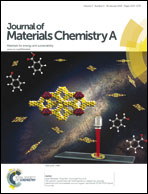An aqueous rechargeable sodium ion battery based on a NaMnO2–NaTi2(PO4)3 hybrid system for stationary energy storage†
Abstract
Due to the costly short-term transients, frequency regulation, and load balancing, the electrical power grid faces an urgent need for large-scale energy storage. The long durability, high power and energy density, and low cost needed for stationary energy storage posing constant challenges for conventional battery technology inspire people to explore new kinds of energy storage technologies. Here, we assembled an aqueous rechargeable sodium ion battery by using NaMnO2 as a cathode material and NaTi2(PO4)3/C composites as anode materials in 2 M CH3COONa aqueous electrolyte. This battery system could work in a wide voltage range from 0.5 V to 1.8 V, giving an energy density of 30 W h kg−1 (based on the total mass of active materials) and could retain 75% of the initial capacity after 500 cycles at the 5 C rate. What is more, the earth-abundant precursors, environmental friendliness and inherent safety made this battery system particularly attractive for stationary energy storage applications.


 Please wait while we load your content...
Please wait while we load your content...